Oxygen Vacancies-Rich S-Cheme BiOBr/CdS Heterojunction with Synergetic Effect for Highly Efficient Light Emitting Diode-Driven Pollutants Degradation
Abstract
:1. Introduction
2. Materials and Methods
2.1. Materials
2.2. Synthesis
2.3. Characterization
2.4. Photocatalytic Test
2.5. Theoretical Calculations
3. Results
3.1. Structure and Morphology
3.2. Optical Property
3.3. Enhanced Photocatalytic Performance
3.4. Band Structure and Density of States by DFT Calculation
3.5. Photocatalytic Mechanism
4. Conclusions
Supplementary Materials
Author Contributions
Funding
Data Availability Statement
Conflicts of Interest
References
- Wang, H.; Wang, H.; Wang, Z.; Tang, L.; Zeng, G.; Xu, P.; Chen, M.; Xiong, T.; Zhou, C.; Li, X. Covalent organic framework photocatalysts: Structures and applications. Chem. Soc. Rev. 2020, 49, 4135–4165. [Google Scholar] [CrossRef] [PubMed]
- Mudhoo, A.; Paliya, S.; Goswami, P.; Singh, M.; Lofrano, G.; Carotenuto, M.; Carraturo, F.; Libralato, G.; Guida, M.; Usman, M. Fabrication, functionalization and performance of doped photocatalysts for dye degradation and mineralization: A review. Environ. Chem. Lett. 2020, 18, 1825–1903. [Google Scholar] [CrossRef]
- Wang, R.; Shan, G.; Wang, T.; Yin, D.; Chen, Y. Photothermal enhanced photocatalytic activity based on Ag-doped CuS nanocomposites. J. Alloys compd. 2021, 864, 158591. [Google Scholar] [CrossRef]
- Li, T.; Zhang, L.; Gao, Y.; Xing, X.; Zhang, X.; Li, F.; Hu, C. Detoxification and selective separation of Cr (VI) and As (III) in wastewater based on interfacial coupling in BiOBr with {110} facet under visible-light irradiation. Appl. Catal. B: Environ. 2022, 307, 121192. [Google Scholar] [CrossRef]
- Zhang, C.; Li, N.; Chen, D.; Xu, Q.; Li, H.; He, J.; Lu, J. The ultrasonic-induced-piezoelectric enhanced photocatalytic performance of ZnO/CdS nanofibers for degradation of bisphenol A. J. Alloys Compd. 2021, 885, 160987. [Google Scholar] [CrossRef]
- Chen, F.; Jin, X.; Cao, Y.; Jia, D.; Liu, A.; Wu, R.; Long, M. Effects of the synthesis conditions on the photocatalytic activities of sulfide-graphene oxide composites. Dyes Pigments 2019, 162, 177–188. [Google Scholar] [CrossRef]
- Wang, B.; Chen, C.; Jiang, Y.; Ni, P.; Zhang, C.; Yang, Y.; Lu, Y.; Liu, P. Rational designing 0D/1D Z-scheme heterojunction on CdS nanorods for efficient visible-light-driven photocatalytic H2 evolution. Chem. Eng. J. 2021, 412, 128690. [Google Scholar] [CrossRef]
- Liu, Y.; Hu, Z.; Yu, J.C. Fe enhanced visible-light-driven nitrogen fixation on BiOBr nanosheets. Chem. Mater. 2020, 32, 1488–1494. [Google Scholar] [CrossRef]
- Som, I.; Roy, M. Recent development on titania-based nanomaterial for photocatalytic CO2 reduction: A review. J. Alloys Compd. 2022, 918, 165533. [Google Scholar] [CrossRef]
- Huang, J.; Wang, B.; Hao, Z.; Zhou, Z.; Qu, Y. Boosting charge separation and broadening NIR light response over defected WO3 quantum dots coupled g-C3N4 nanosheets for photocatalytic degrading antibiotics. Chem. Eng. J. 2021, 416, 129109. [Google Scholar] [CrossRef]
- Zhao, W.; He, M.; Chen, F.; Jin, X.; Duan, H.; Long, M.; Wu, Z.; Cao, B.; Yu, Y. One-pot synthesis of flower-like SnS2/SnO2 heterojunction with enhanced visible light photocatalytic performance. Opt. Mater. 2022, 123, 111934. [Google Scholar] [CrossRef]
- Lou, T.; Song, S.; Gao, X.; Qian, W.; Chen, X.; Li, Q. Sub-20-nm anatase TiO2 anchored on hollow carbon spheres for enhanced photocatalytic degradation of reactive red 195. J. Colloid Interface Sci. 2022, 617, 663–672. [Google Scholar] [CrossRef]
- Tai, Z.; Sun, G.; Wang, T.; Fang, Z.; Hou, X.; Li, F.; Qiu, Y.; Ye, Q.; Jia, L.; Wang, H. Defected tungsten disulfide decorated CdS nanorods with covalent heterointerfaces for boosted photocatalytic H2 generation. J. Colloid Interface Sci. 2022, 628, 252–260. [Google Scholar] [CrossRef]
- Goktas, A.; Modanlı, S.; Tumbul, A.; Kilic, A. Facile synthesis and characterization of ZnO, ZnO: Co, and ZnO/ZnO: Co nano rod-like homojunction thin films: Role of crystallite/grain size and microstrain in photocatalytic performance. J.Alloys Compd. 2022, 893, 162334. [Google Scholar] [CrossRef]
- Huang, Y.; Yu, Y.; Yu, Y.; Zhang, B. Oxygen vacancy engineering in photocatalysis. Solar RRL 2020, 4, 2000037. [Google Scholar] [CrossRef]
- Guo, J.; Li, X.; Liang, J.; Yuan, X.; Jiang, L.; Yu, H.; Sun, H.; Zhu, Z.; Ye, S.; Tang, N. Fabrication and regulation of vacancy-mediated bismuth oxyhalide towards photocatalytic application: Development status and tendency. Coord. Chem. Rev. 2021, 443, 214033. [Google Scholar] [CrossRef]
- Wang, Y.; Zhang, Y.; Liu, Y.; Wu, Z. Fluorine-induced oxygen vacancies on TiO2 nanosheets for photocatalytic indoor VOCs degradation. Appl. Catal. B Environ. 2022, 316, 121610. [Google Scholar] [CrossRef]
- Liu, J.; Zhang, Q.; Tian, X.; Hong, Y.; Nie, Y.; Su, N.; Jin, G.; Zhai, Z.; Fu, C. Highly efficient photocatalytic degradation of oil pollutants by oxygen deficient SnO2 quantum dots for water remediation. Chem. Eng. J. 2021, 404, 127146. [Google Scholar] [CrossRef]
- Ni, J.; Wang, W.; Liu, D.; Zhu, Q.; Jia, J.; Tian, J.; Li, Z.; Wang, X.; Xing, Z. Oxygen vacancy-mediated sandwich-structural TiO2−x/ultrathin g-C3N4/TiO2−x direct Z-scheme heterojunction visible-light-driven photocatalyst for efficient removal of high toxic tetracycline antibiotics. J. Hazard. Mater. 2021, 408, 124432. [Google Scholar] [CrossRef]
- Wang, Y.; Hu, X.; Song, H.; Cai, Y.; Li, Z.; Zu, D.; Zhang, P.; Chong, D.; Gao, N.; Shen, Y. Oxygen vacancies in actiniae-like Nb2O5/Nb2C MXene heterojunction boosting visible light photocatalytic NO removal. Appl. Catal. B Environ. 2021, 299, 120677. [Google Scholar] [CrossRef]
- Liu, G.; Hou, G.; Mao, X.; Qi, X.; Song, Y.; Ma, X.; Wu, J.; Luo, G.; Yao, H.; Liu, Q. Rational design of CeO2/Bi7O9I3 flower-like nanosphere with Z-scheme heterojunction and oxygen vacancy for enhancing photocatalytic activity. Chem. Eng. J. 2022, 431, 133254. [Google Scholar] [CrossRef]
- Feng, Y.; Zhang, Z.; Zhao, K.; Lin, S.; Li, H.; Gao, X. Photocatalytic nitrogen fixation: Oxygen vacancy modified novel micro-nanosheet structure Bi2O2CO3 with band gap engineering. J. Colloid Interface Sci. 2021, 583, 499–509. [Google Scholar] [CrossRef] [PubMed]
- Zhao, J.; Miao, Z.; Zhang, Y.; Wen, G.; Liu, L.; Wang, X.; Cao, X.; Wang, B. Oxygen vacancy-rich hierarchical BiOBr hollow microspheres with dramatic CO2 photoreduction activity. J. Colloid Interface Sci. 2021, 593, 231–243. [Google Scholar] [CrossRef] [PubMed]
- Wang, W.; Tao, Y.; Fan, J.; Yan, Z.; Shang, H.; Phillips, D.L.; Chen, M.; Li, G. Fullerene–Graphene Acceptor Drives Ultrafast Carrier Dynamics for Sustainable CdS Photocatalytic Hydrogen Evolution. Adv. Func Mater. 2022, 32, 2201357. [Google Scholar] [CrossRef]
- Wang, J.; Zhu, Q.; Liao, Y.; Fu, H.; Chang, J.; Zhang, Y.; Kan, T.; Gao, H.; Huang, W. Efficient enhancement of photocatalytic hydrogen evolution of CdS nanorods by Nano-CuO. J. Alloys Compd. 2021, 883, 160832. [Google Scholar] [CrossRef]
- Yang, W.; Xu, M.; Tao, K.Y.; Zhang, J.H.; Zhong, D.C.; Lu, T.B. Building 2D/2D CdS/MOLs Heterojunctions for Efficient Photocatalytic Hydrogen Evolution. Small 2022, 18, 2200332. [Google Scholar] [CrossRef] [PubMed]
- Wang, G.; Dou, K.; Cao, H.; Du, R.; Liu, J.; Tsidaeva, N.; Wang, W. Designing Z-scheme CdS/WS2 heterojunctions with enhanced photocatalytic degradation of organic dyes and photoreduction of Cr (VI): Experiments, DFT calculations and mechanism. Sep. Purif. Technol. 2022, 291, 120976. [Google Scholar] [CrossRef]
- Guo, Y.; Huang, H.; He, Y.; Tian, N.; Zhang, T.; Chu, P.K.; An, Q.; Zhang, Y. In situ crystallization for fabrication of a core–satellite structured BiOBr–CdS heterostructure with excellent visible-light-responsive photoreactivity. Nanoscale 2015, 7, 11702–11711. [Google Scholar] [CrossRef]
- Cui, H.; Zhou, Y.; Mei, J.; Li, Z.; Xu, S.; Yao, C. Synthesis of CdS/BiOBr nanosheets composites with efficient visible-light photocatalytic activity. J. Phys. Chem. Solids. 2018, 112, 80–87. [Google Scholar] [CrossRef]
- You, J.; Wang, L.; Bao, W.; Yan, A.; Guo, R. Synthesis and visible-light photocatalytic properties of BiOBr/CdS nanomaterials. J. Mater. Sci. 2021, 56, 6732–6744. [Google Scholar] [CrossRef]
- Kresse, G.; Furthmüller, J. Efficient iterative schemes for ab initio total-energy calculations using a plane-wave basis set. Phys. Rev. B 1996, 54, 11169. [Google Scholar] [CrossRef] [PubMed]
- Perdew, J.P.; Burke, K.; Ernzerhof, M. Generalized gradient approximation made simple. Phys. Rev. Lett. 1996, 77, 3865. [Google Scholar] [CrossRef] [PubMed] [Green Version]
- Liao, J.; Chen, L.; Sun, M.; Lei, B.; Zeng, X.; Sun, Y.; Dong, F. Improving visible-light-driven photocatalytic NO oxidation over BiOBr nanoplates through tunable oxygen vacancies. Chin. J. Catal. 2018, 39, 779–789. [Google Scholar] [CrossRef]
- Xue, X.; Chen, R.; Chen, H.; Hu, Y.; Ding, Q.; Liu, Z.; Ma, L.; Zhu, G.; Zhang, W.; Yu, Q. Oxygen vacancy engineering promoted photocatalytic ammonia synthesis on ultrathin two-dimensional bismuth oxybromide nanosheets. Nano Lett. 2018, 18, 7372–7377. [Google Scholar] [CrossRef]
- Bai, S.; Wang, L.; Li, Z.; Xiong, Y. Facet-engineered surface and interface design of photocatalytic materials. Adv. Sci. 2017, 4, 1600216. [Google Scholar] [CrossRef] [Green Version]
- Di, J.; Chen, C.; Chao, Z.; Ji, M.; Xia, J.; Cheng, Y.; Hao, W.; Li, S.; Li, H.; Zheng, L. Bismuth vacancy mediated single unit cell Bi2WO6 nanosheets for boosting photocatalytic oxygen evolution. Appl. Catal. B Environ. 2018, 238, 119–125. [Google Scholar] [CrossRef]
- Li, D.; Zhang, W.; Niu, Z.; Zhang, Y. Improvement of photocatalytic activity of BiOBr and BiOBr/ZnO under visible-light irradiation by short-time low temperature plasma treatment. J. Alloys Compd. 2022, 924, 166608. [Google Scholar] [CrossRef]
- Liu, D.; Chen, D.; Li, N.; Xu, Q.; Li, H.; He, J.; Lu, J. Surface engineering of g-C3N4 by stacked BiOBr sheets rich in oxygen vacancies for boosting photocatalytic performance. Angew. Chem. Int. Edit. 2020, 59, 4519–4524. [Google Scholar] [CrossRef]
- Sun, D.; Huang, C.; Yuan, Y.; Ma, Y.; Hao, H.; Li, R.; Bingshe, X. Synthesis and photocatalytic activity of BiOBr hierarchical structures constructed by porous nanosheets with exposed (110) facets. Catal. Today 2019, 335, 429–436. [Google Scholar] [CrossRef]
- Qu, J.; Sun, X.; Yang, C.; Xue, L.; Li, Z.; Cui, B.; Hu, Y.; Du, Y.; Ji, P. Novel pn type polyimide aerogels/BiOBr heterojunction for visible light activated high efficient photocatalytic degradation of organic contaminants. J. Alloys Compd. 2022, 900, 163469. [Google Scholar] [CrossRef]
- Guo, C.; Chu, L.; Zhang, Q.; Li, Z.; Yang, G.; Peng, F. The zinc vacancy induced CdS/ZnS Z-scheme structure as a highly stable photocatalyst for hydrogen production. J. Alloys Compd. 2021, 888, 161620. [Google Scholar] [CrossRef]
- Zhou, C.; Shi, X.; Li, D.; Song, Q.; Zhou, Y.; Jiang, D.; Shi, W. Oxygen vacancy engineering of BiOBr/HNb3O8 Z-scheme hybrid photocatalyst for boosting photocatalytic conversion of CO2. J. Colloid Interface Sci. 2021, 599, 245–254. [Google Scholar] [CrossRef] [PubMed]
- Zhang, Y.; Gu, S.; Zhou, X.; Gao, K.; Wang, X. Boosted photocatalytic nitrogen fixation by bismuth and oxygen vacancies in Bi2MoO6/BiOBr composite structures. Catal. Sci. Technol. 2021, 11, 4783–4792. [Google Scholar] [CrossRef]
- Ni, J.; Liu, D.; Wang, W.; Wang, A.; Jia, J.; Tian, J.; Xing, Z. Hierarchical defect-rich flower-like BiOBr/Ag nanoparticles/ultrathin g-C3N4 with transfer channels plasmonic Z-scheme heterojunction photocatalyst for accelerated visible-light-driven photothermal-photocatalytic oxytetracycline degradation. Chem. Eng. J. 2021, 419, 129969. [Google Scholar] [CrossRef]
- Zhong, W.; Tu, W.; Feng, S.; Xu, A. Photocatalytic H2 evolution on CdS nanoparticles by loading FeSe nanorods as co-catalyst under visible light irradiation. J. Alloys Compd. 2019, 772, 669–674. [Google Scholar] [CrossRef]
- Okla, M.K.; Janani, B.; Swetha, S.; Alatar, A.A.; Alaraidh, I.A.; Al-ghamdi, A.A.; Abdelaziz, R.F.; Abdel-Maksoud, M.A.; Rahiman, M.K.; Khan, S.S. Environmental friendly nano-star CdS coupled ZnS on bi-polymer matrix: Unravelling defects-rich nanoplatform for ultrahigh white light active direct S-scheme photodegradation of organic pollutants. J. Alloys Compd. 2022, 925, 166611. [Google Scholar] [CrossRef]
- Li, J.; Xiao, X.; Xiao, Y.; Lu, M. Construction of Z-scheme BiOCl/Bi24O31Br10 hierarchical heterostructures with enhanced photocatalytic activity. J. Alloys Compd. 2022, 921, 166050. [Google Scholar] [CrossRef]
- Yang, Q.; Qin, W.; Xie, Y.; Zong, K.; Guo, Y.; Song, Z.; Luo, G.; Raza, W.; Hussain, A.; Ling, Y. Constructing 2D/1D heterostructural BiOBr/CdS composites to promote CO2 photoreduction. Sep. Purif. Technol. 2022, 298, 121603. [Google Scholar] [CrossRef]
- Zhang, N.; Li, X.; Ye, H.; Chen, S.; Ju, H.; Liu, D.; Lin, Y.; Ye, W.; Wang, C.; Xu, Q. Oxide defect engineering enables to couple solar energy into oxygen activation. J. Am. Chem. Soc. 2016, 138, 8928–8935. [Google Scholar] [CrossRef]
- Liu, L.; Liu, J.; Yang, W.; Wan, J.; Fu, F.; Wang, D. Constructing a Z-scheme ZnIn2S4-S/CNTs/RP nanocomposite with modulated energy band alignment for enhanced photocatalytic hydrogen evolution. J. Colloid Interface Sci. 2022, 608, 482–492. [Google Scholar] [CrossRef]
- Zhang, F.; Zhang, Y.; Wang, Y.; Zhu, A.; Zhang, Y. Efficient photocatalytic reduction of aqueous Cr (VI) by Zr4+ doped and polyaniline coupled SnS2 nanoflakes. Sep. Purif. Technol. 2022, 283, 120161. [Google Scholar] [CrossRef]
- Zhang, D.; Wu, M.; Hao, J.; Zheng, S.; Yang, Y.; Yao, T.; Wang, Y. Construction of Z-scheme heterojunction by coupling Bi2Sn2O7 and BiOBr with abundant oxygen vacancies: Enhanced photodegradation performance and mechanism insight. J. Colloid Interface Sci. 2022, 612, 550–561. [Google Scholar] [CrossRef] [PubMed]
- Shang, Y.; Fan, H.; Chen, Y.; Dong, W.; Wang, W. Synergism between nitrogen vacancies and a unique electrons transfer pathway of Ag modified S-scheme g-C3N4/CdS heterojunction for efficient H2 evolution. J. Alloys Compd. 2023, 933, 167620. [Google Scholar] [CrossRef]
- Xiao, Y.; Wang, H.; Jiang, Y.; Zhang, W.; Zhang, J.; Wu, X.; Liu, Z.; Deng, W. Hierarchical Sb2S3/ZnIn2S4 core–shell heterostructure for highly efficient photocatalytic hydrogen production and pollutant degradation. J. Colloid Interface Sci. 2022, 623, 109–123. [Google Scholar] [CrossRef] [PubMed]
- Bai, J.; Yang, Y.; Hu, X.; Lu, P.; Fu, M.; Ren, X. Fabrication of novel organic/inorganic polyimide-BiPO4 heterojunction for enhanced photocatalytic degradation performance. J. Colloid Interface Sci. 2022, 625, 512–520. [Google Scholar] [CrossRef] [PubMed]
- Li, X.; Kang, B.; Dong, F.; Deng, F.; Han, L.; Gao, X.; Xu, J.; Hou, X.; Feng, Z.; Chen, Z. BiOBr with oxygen vacancies capture 0D black phosphorus quantum dots for high efficient photocatalytic ofloxacin degradation. Appl. Surf. Sci. 2022, 593, 153422. [Google Scholar] [CrossRef]
- Zhao, Y.; Guo, H.; Liu, J.; Xia, Q.; Liu, J.; Liang, X.; Liu, E.; Fan, J. Effective photodegradation of rhodamine B and levofloxacin over CQDs modified BiOCl and BiOBr composite: Mechanism and toxicity assessment. J. Colloid Interface Sci. 2022, 627, 180–193. [Google Scholar] [CrossRef] [PubMed]
- Miao, Z.; Wang, Q.; Zhang, Y.; Meng, L.; Wang, X. In situ construction of S-scheme AgBr/BiOBr heterojunction with surface oxygen vacancy for boosting photocatalytic CO2 reduction with H2O. Appl. Catal. B Environ. 2022, 301, 120802. [Google Scholar] [CrossRef]
- Marchuk, M.V.; Asanov, I.P.; Panafidin, M.A.; Vorotnikov, Y.A.; Shestopalov, M.A. Nano TiO2 and Molybdenum/Tungsten Iodide Octahedral Clusters: Synergism in UV/Visible-Light Driven Degradation of Organic Pollutants. Nanomaterials 2022, 12, 4282. [Google Scholar] [CrossRef]
- Wang, C.; Liu, H.; Wang, G.; Huang, W.; Wei, Z.; Fang, H.; Shen, F. Visible light driven S-scheme heterojunction Zn3In2S6/Bi2MoO6 for efficient degradation of metronidazole. J. Alloys Compd. 2022, 917, 165507. [Google Scholar] [CrossRef]
- Han, H.; Wang, X.; Qiao, Y.; Lai, Y.; Liu, B.; Zhang, Y.; Luo, J.; Toan, S.; Wang, L. Construction of S-scheme heterojunction for enhanced photocatalytic conversation of NO over dual-defect CeO2-x/g-C3N4-x. J. Alloys Compd. 2022, 933, 167819. [Google Scholar] [CrossRef]
- Liu, S.; Chen, J.; Liu, D.; Shan, L.; Zhang, X. Improved visible light photocatalytic performance through an in situ composition-transforming synthesis of BiVO4/BiOBr photocatalyst. J Nanopart Res. 2019, 21, 1–10. [Google Scholar] [CrossRef]
- Xing, Y.; He, Z.; Que, W. Synthesis and characterization of ZnO nanospheres sensitized BiOBr plates with enhanced photocatalytic performances. Mater Lett. 2016, 182, 210–213. [Google Scholar] [CrossRef]
- Zhang, J.; Lv, J.; Dai, K.; Liang, C.; Liu, Q. One-step growth of nanosheet-assembled BiOCl/BiOBr microspheres for highly efficient visible photocatalytic performance. Appl. Surf. Sci. 2018, 430, 639–646. [Google Scholar] [CrossRef]
- Zhao, H.j.; Wu, R.J.; Wang, X.C.; An, Y.m.; Zhao, W.X.; Ma, F. Heterojunction of BiPO4/BiOBr photocatalysts for Rhodamine B dye degradation under visible LED light irradiation. J Chin Chem Soc-Taip. 2020, 67, 1016–1023. [Google Scholar] [CrossRef]
- Hu, T.; Yang, Y.; Dai, K.; Zhang, J.; Liang, C. A novel Z-scheme Bi2MoO6/BiOBr photocatalyst for enhanced photocatalytic activity under visible light irradiation. Appl. Surf. Sci. 2018, 456, 473–481. [Google Scholar] [CrossRef]
- Tu, X.; Qian, S.; Chen, L.; Qu, L. The influence of Sn (II) doping on the photoinduced charge and photocatalytic properties of BiOBr microspheres. J Mater Sci. 2015, 50, 4312–4323. [Google Scholar] [CrossRef]
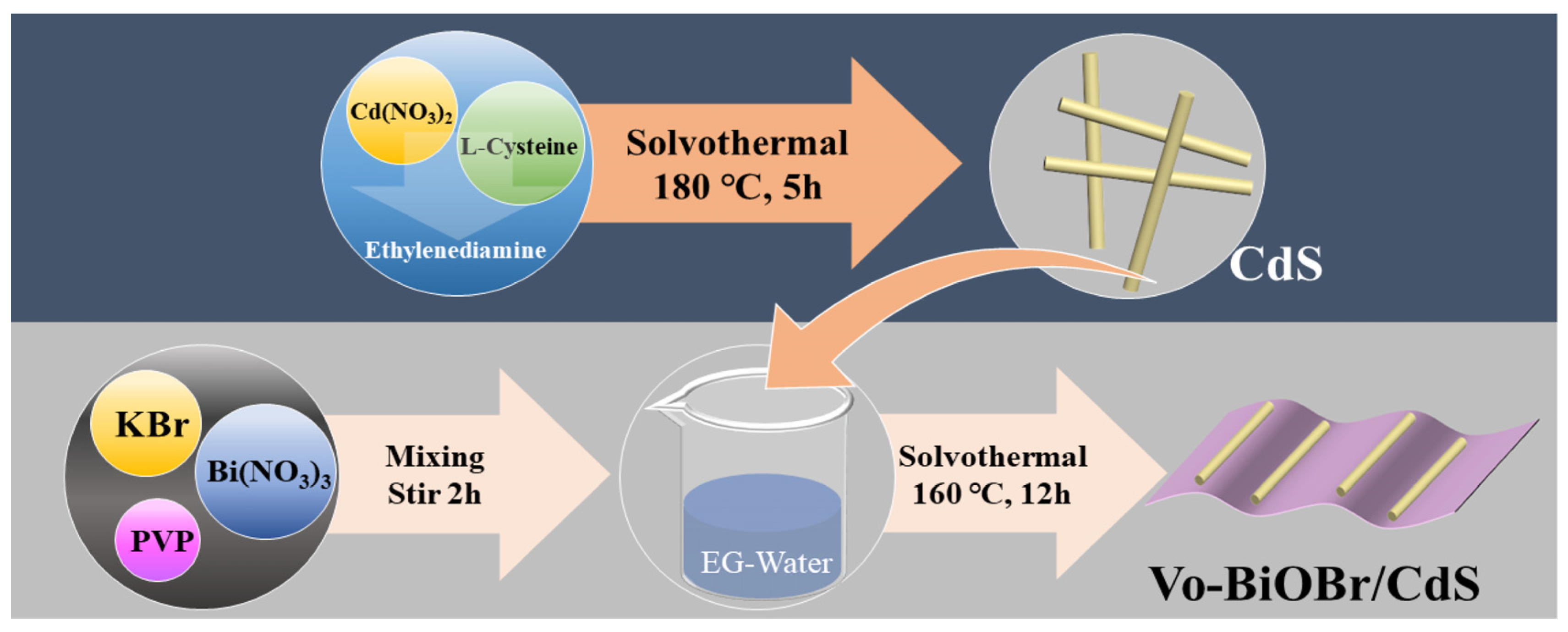


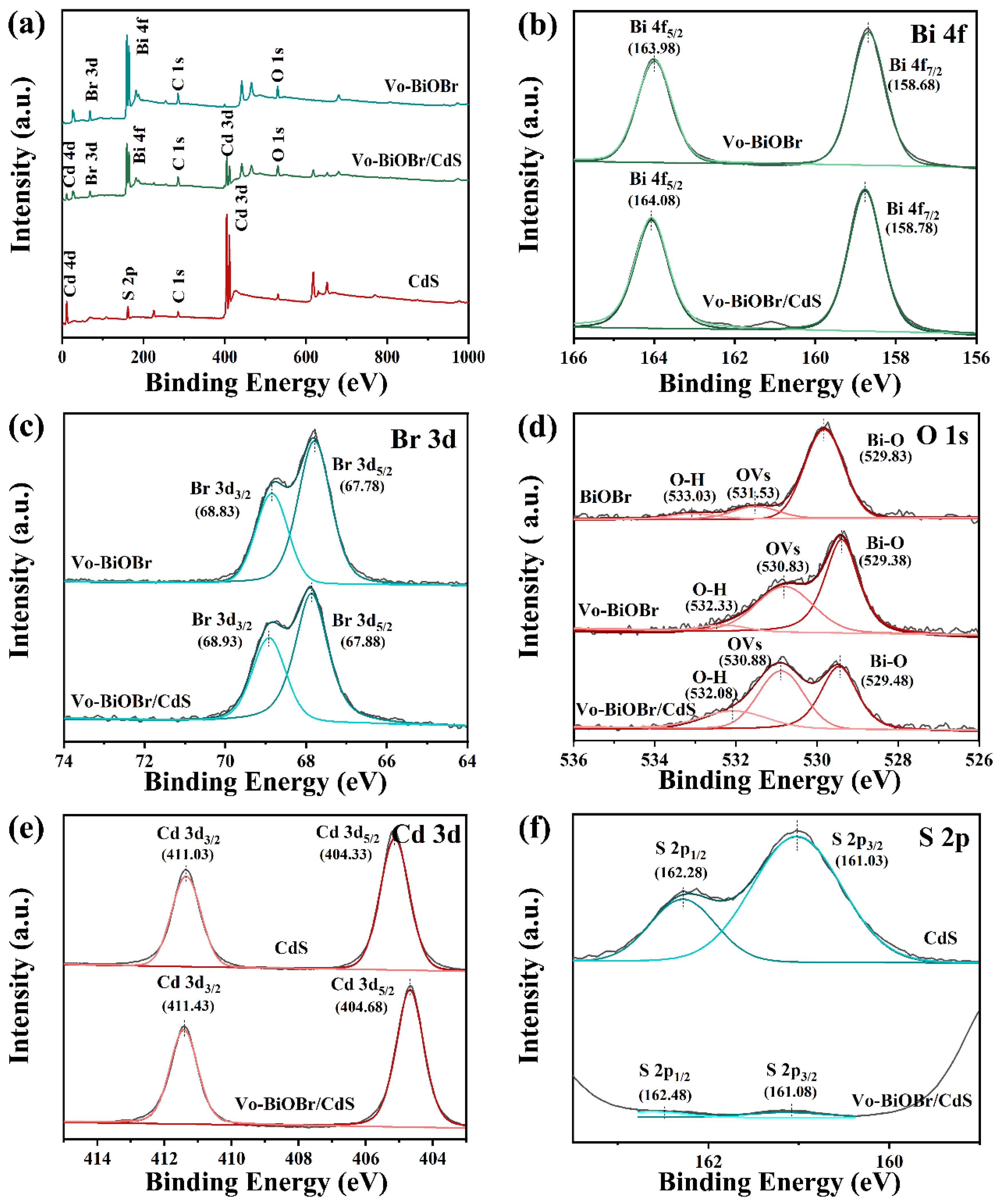


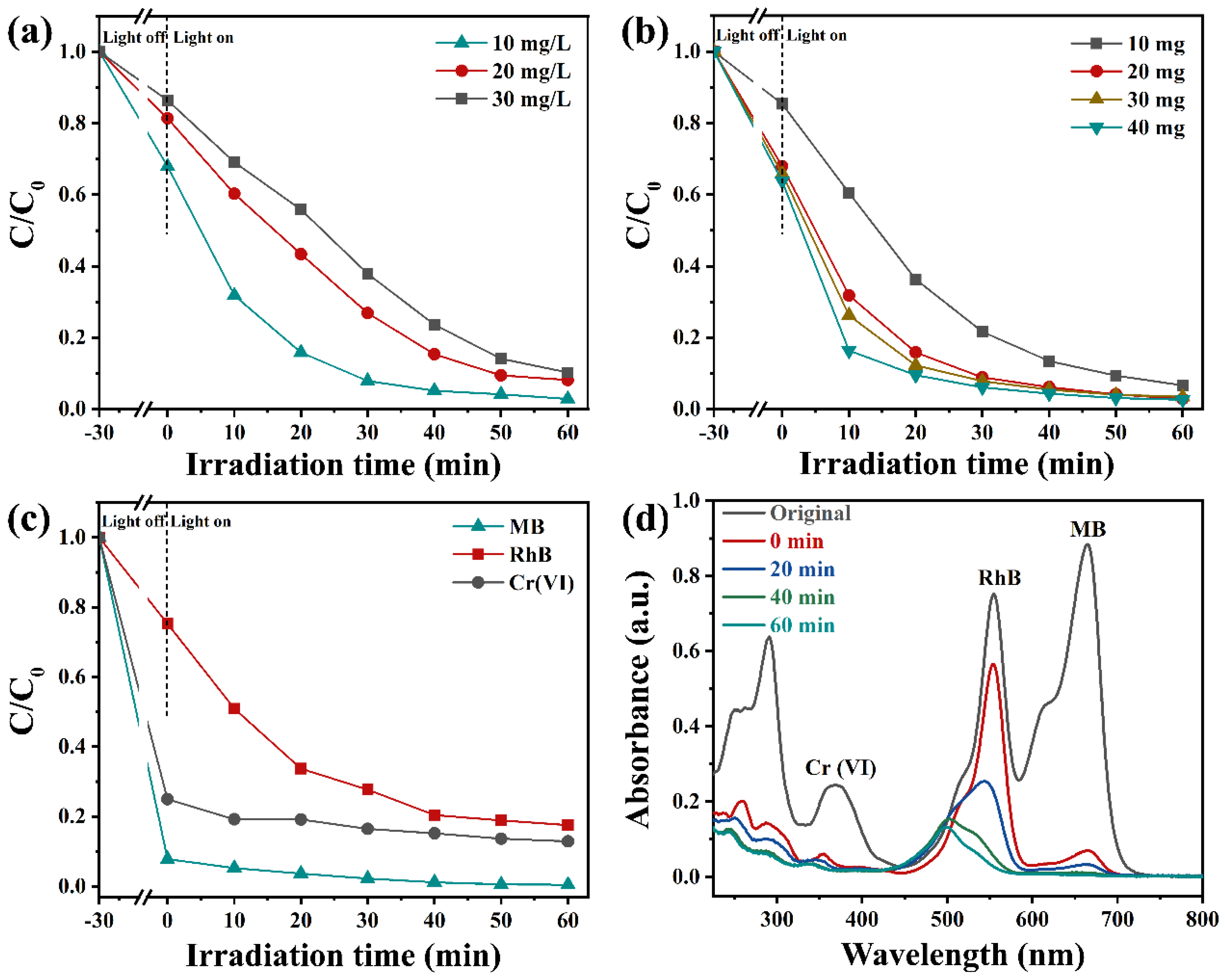
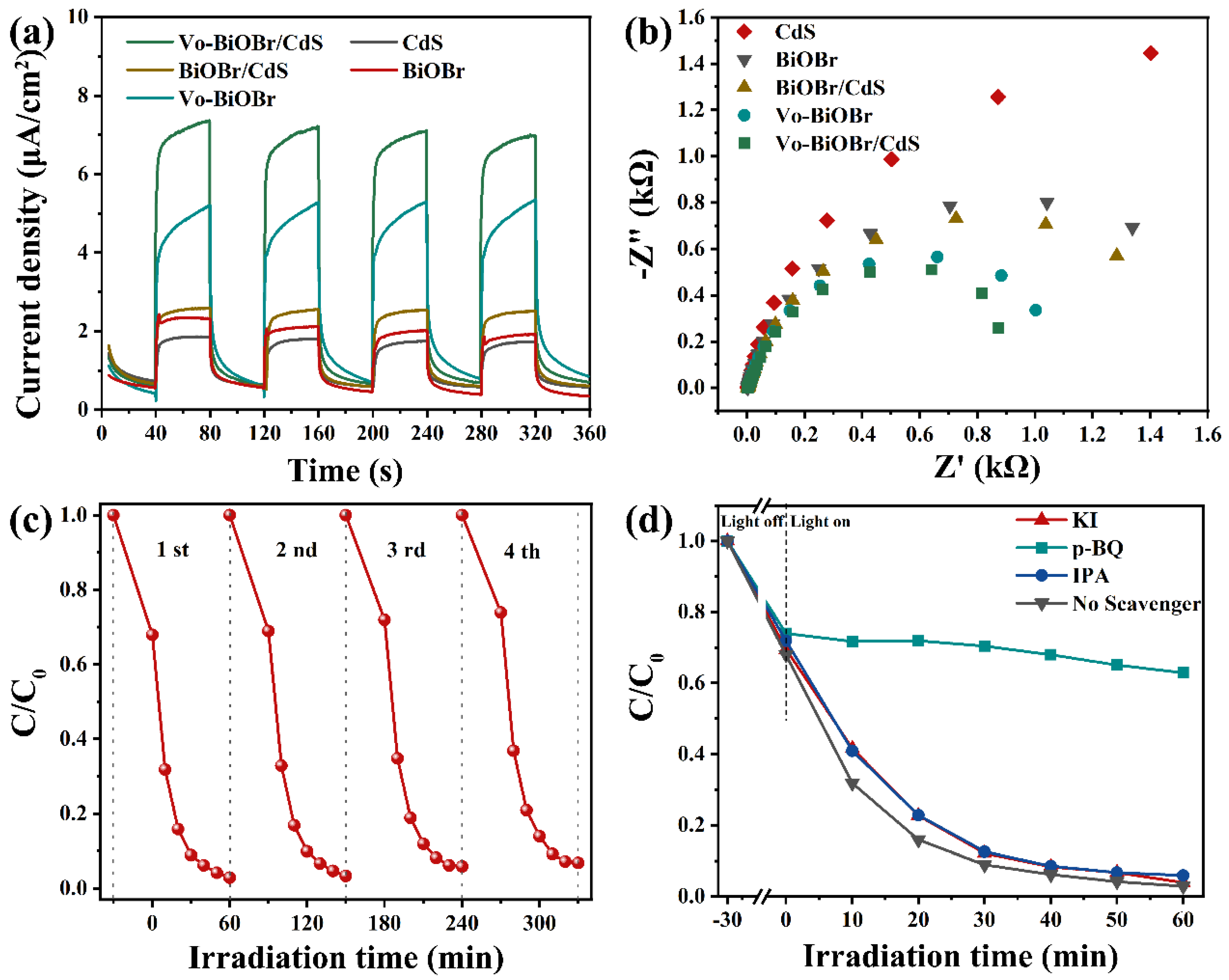
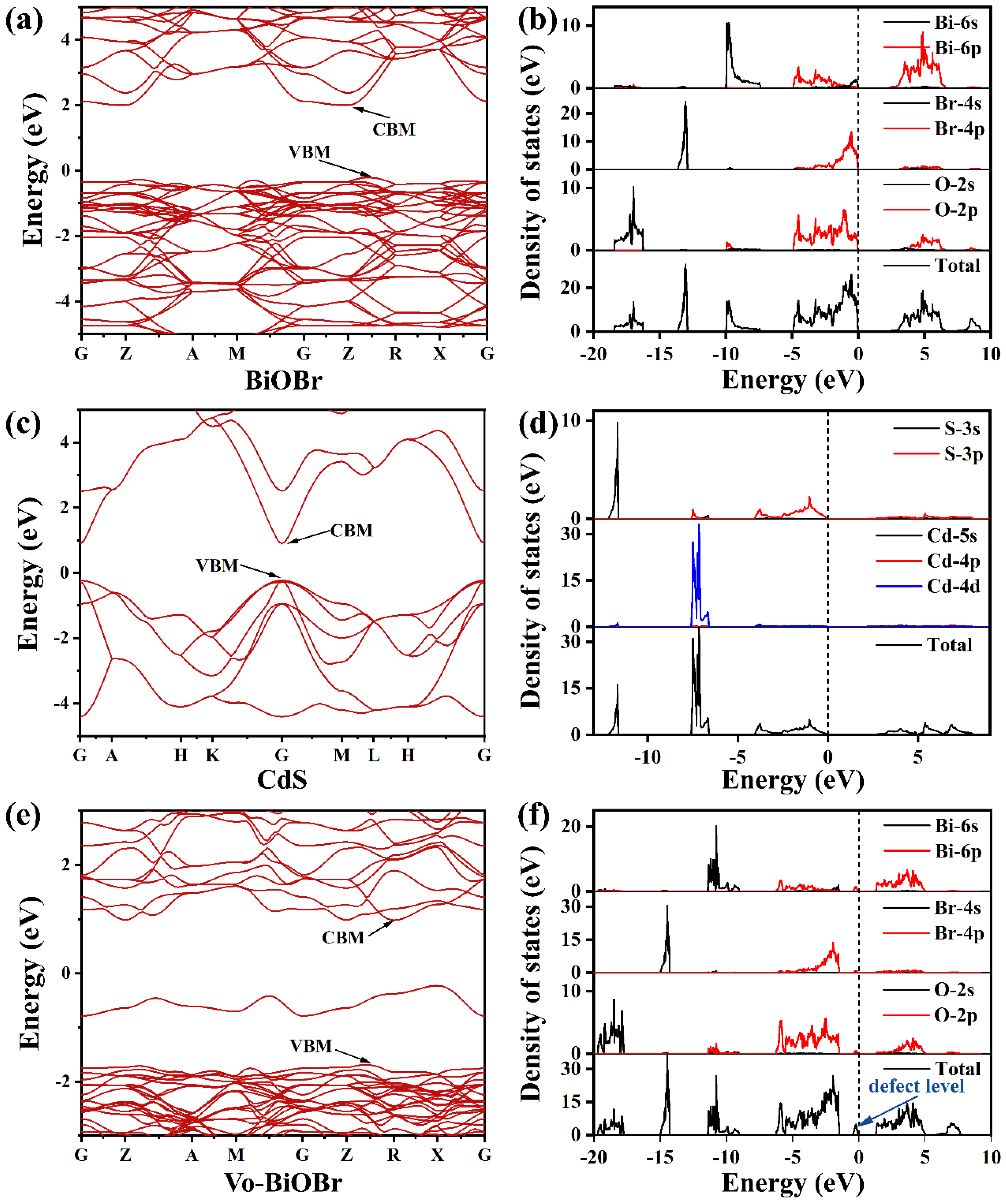
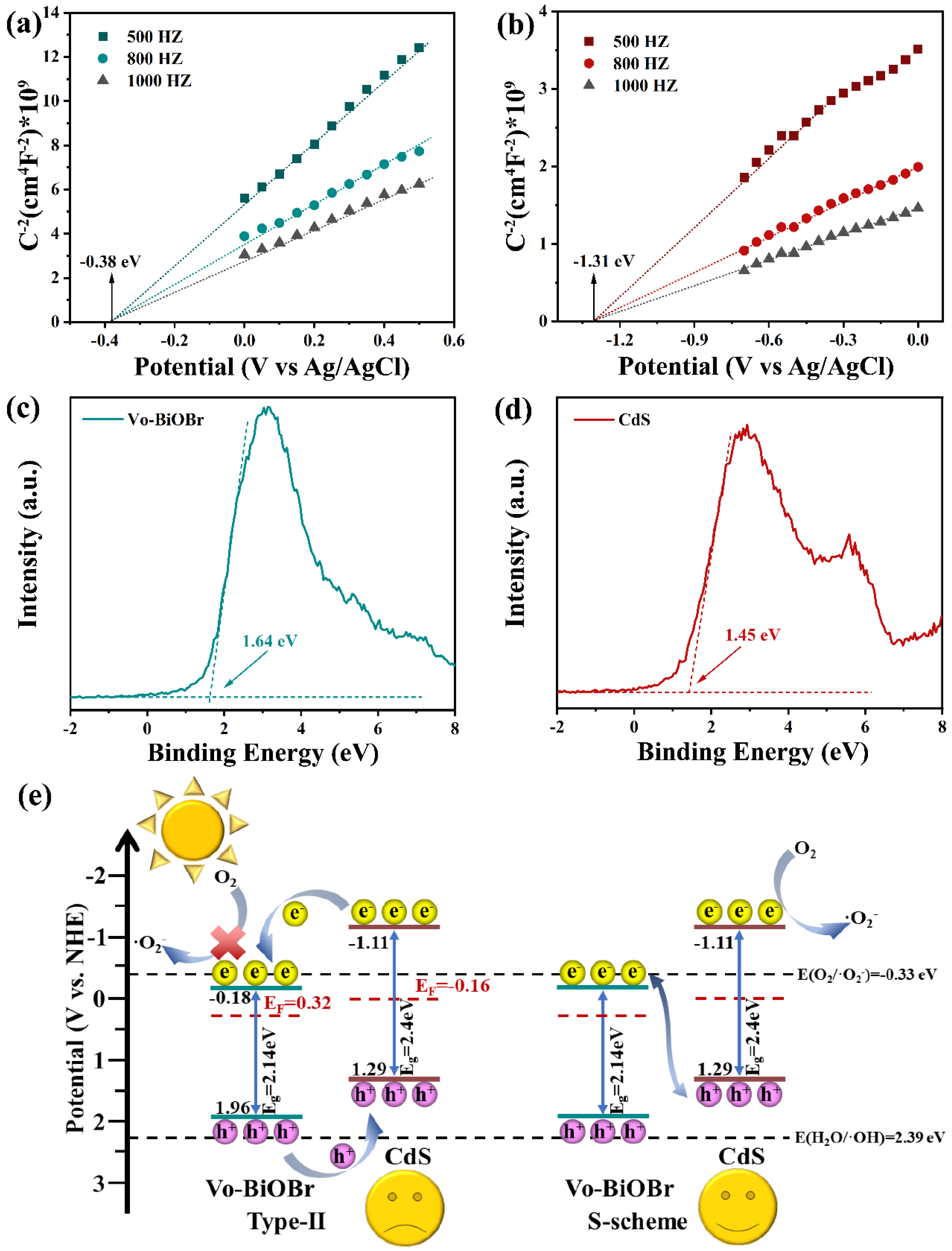

Disclaimer/Publisher’s Note: The statements, opinions and data contained in all publications are solely those of the individual author(s) and contributor(s) and not of MDPI and/or the editor(s). MDPI and/or the editor(s) disclaim responsibility for any injury to people or property resulting from any ideas, methods, instructions or products referred to in the content. |
© 2023 by the authors. Licensee MDPI, Basel, Switzerland. This article is an open access article distributed under the terms and conditions of the Creative Commons Attribution (CC BY) license (https://creativecommons.org/licenses/by/4.0/).
Share and Cite
Yu, Y.; Chen, F.; Jin, X.; Min, J.; Duan, H.; Li, J.; Wu, Z.; Cao, B. Oxygen Vacancies-Rich S-Cheme BiOBr/CdS Heterojunction with Synergetic Effect for Highly Efficient Light Emitting Diode-Driven Pollutants Degradation. Nanomaterials 2023, 13, 830. https://doi.org/10.3390/nano13050830
Yu Y, Chen F, Jin X, Min J, Duan H, Li J, Wu Z, Cao B. Oxygen Vacancies-Rich S-Cheme BiOBr/CdS Heterojunction with Synergetic Effect for Highly Efficient Light Emitting Diode-Driven Pollutants Degradation. Nanomaterials. 2023; 13(5):830. https://doi.org/10.3390/nano13050830
Chicago/Turabian StyleYu, Yang, Fengjuan Chen, Xuekun Jin, Junyong Min, Haiming Duan, Jin Li, Zhaofeng Wu, and Biaobing Cao. 2023. "Oxygen Vacancies-Rich S-Cheme BiOBr/CdS Heterojunction with Synergetic Effect for Highly Efficient Light Emitting Diode-Driven Pollutants Degradation" Nanomaterials 13, no. 5: 830. https://doi.org/10.3390/nano13050830




